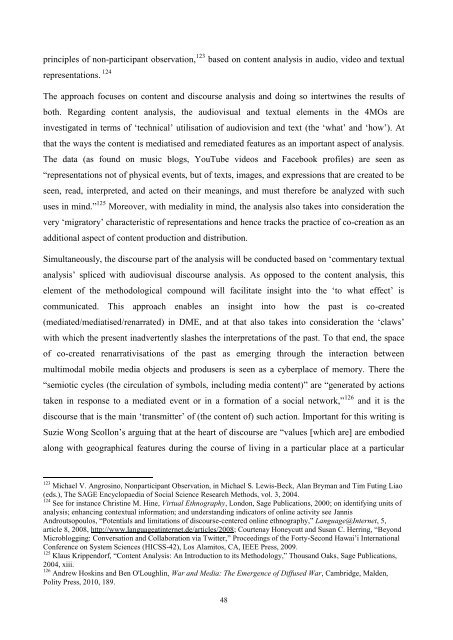UNIVERSITY OF NOVA GORICA GRADUATE SCHOOL ...
UNIVERSITY OF NOVA GORICA GRADUATE SCHOOL ...
UNIVERSITY OF NOVA GORICA GRADUATE SCHOOL ...
You also want an ePaper? Increase the reach of your titles
YUMPU automatically turns print PDFs into web optimized ePapers that Google loves.
principles of non-participant observation, 123 based on content analysis in audio, video and textual<br />
representations. 124<br />
The approach focuses on content and discourse analysis and doing so intertwines the results of<br />
both. Regarding content analysis, the audiovisual and textual elements in the 4MOs are<br />
investigated in terms of ‗technical‘ utilisation of audiovision and text (the ‗what‘ and ‗how‘). At<br />
that the ways the content is mediatised and remediated features as an important aspect of analysis.<br />
The data (as found on music blogs, YouTube videos and Facebook profiles) are seen as<br />
―representations not of physical events, but of texts, images, and expressions that are created to be<br />
seen, read, interpreted, and acted on their meanings, and must therefore be analyzed with such<br />
uses in mind.‖ 125 Moreover, with mediality in mind, the analysis also takes into consideration the<br />
very ‗migratory‘ characteristic of representations and hence tracks the practice of co-creation as an<br />
additional aspect of content production and distribution.<br />
Simultaneously, the discourse part of the analysis will be conducted based on ‗commentary textual<br />
analysis‘ spliced with audiovisual discourse analysis. As opposed to the content analysis, this<br />
element of the methodological compound will facilitate insight into the ‗to what effect‘ is<br />
communicated. This approach enables an insight into how the past is co-created<br />
(mediated/mediatised/renarrated) in DME, and at that also takes into consideration the ‗claws‘<br />
with which the present inadvertently slashes the interpretations of the past. To that end, the space<br />
of co-created renarrativisations of the past as emerging through the interaction between<br />
multimodal mobile media objects and produsers is seen as a cyberplace of memory. There the<br />
―semiotic cycles (the circulation of symbols, including media content)‖ are ―generated by actions<br />
taken in response to a mediated event or in a formation of a social network,‖ 126 and it is the<br />
discourse that is the main ‗transmitter‘ of (the content of) such action. Important for this writing is<br />
Suzie Wong Scollon‘s arguing that at the heart of discourse are ―values [which are] are embodied<br />
along with geographical features during the course of living in a particular place at a particular<br />
123 Michael V. Angrosino, Nonparticipant Observation, in Michael S. Lewis-Beck, Alan Bryman and Tim Futing Liao<br />
(eds.), The SAGE Encyclopaedia of Social Science Research Methods, vol. 3, 2004.<br />
124 See for instance Christine M. Hine, Virtual Ethnography, London, Sage Publications, 2000; on identifying units of<br />
analysis; enhancing contextual information; and understanding indicators of online activity see Jannis<br />
Androutsopoulos, ―Potentials and limitations of discourse-centered online ethnography,‖ Language@Internet, 5,<br />
article 8, 2008, http://www.languageatinternet.de/articles/2008; Courtenay Honeycutt and Susan C. Herring, ―Beyond<br />
Microblogging: Conversation and Collaboration via Twitter,‖ Proceedings of the Forty-Second Hawai‘i International<br />
Conference on System Sciences (HICSS-42), Los Alamitos, CA, IEEE Press, 2009.<br />
125 Klaus Krippendorf, ―Content Analysis: An Introduction to its Methodology,‖ Thousand Oaks, Sage Publications,<br />
2004, xiii.<br />
126 Andrew Hoskins and Ben O'Loughlin, War and Media: The Emergence of Diffused War, Cambridge, Malden,<br />
Polity Press, 2010, 189.<br />
48

















